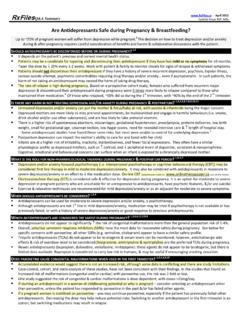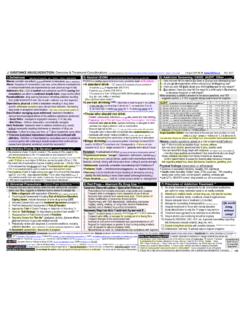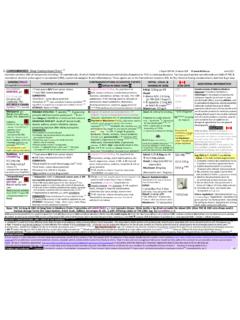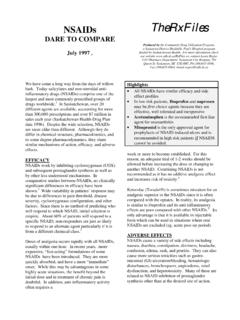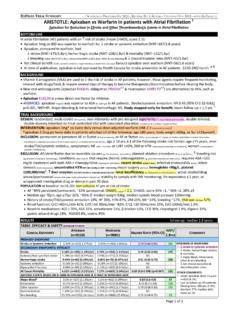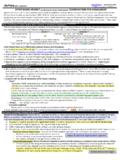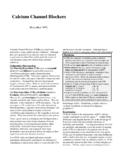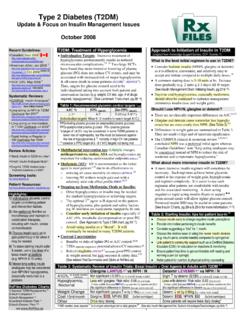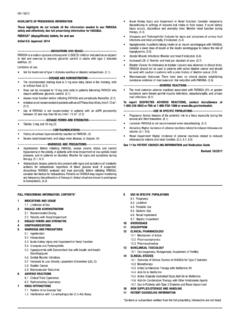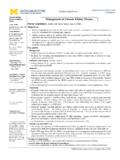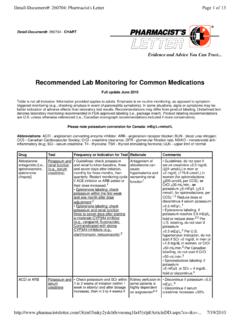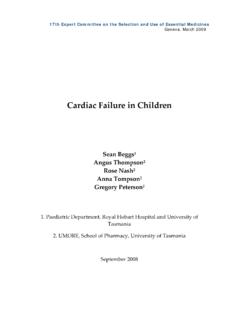Transcription of POST-MI - RxFiles
1 post -MITroubleshooting Practical IssuesOctober 2004 The RxFiles Academic Detailing Programin collaboration withDerek Jorgenson, Health Quality Council (HQC)701 Queen StreetSaskatoon City HospitalSaskatoon, SK S7K 0M7 Phone 306-655-8506 ; Fax 306-655-7980 Email: Message: Four types of medication (ACE-Inhibitors, beta-blockers,statins & ASA) have been shown to reduce cardiovascularrisk in POST-MI patients. 1 These benefits are in addition torisk factor management (eg. diet 2,3,4, lifestyle, exercise) andoccur regardless of the presence of hypertension,dyslipidemia, or LV dysfunction.
2 Clinical judgment isessential to assess risk/benefit for individual are we doing in Saskatchewan? An analysis of Saskatchewan dispensing rates by the HQCsuggests that important drugs are underutilized (See Figure 1).PRACTICAL ISSUES ACE Inhibitors (ACEI)Which patients will benefit? All post MI patients without contraindications 1 (indefinitely) Shown to reduce risk of CV events in POST-MI patients whoare high risk 5,6,7 (elderly, LV dysfunction); some benefit alsoin lower risk 8,9 patients ( young, no LV dysfunction) Beneficial when initiated soon after acute MI 1 (~first 24hrs) AHA 04 Initiation & dosing in patients with renal dysfunction 10 Ensure SCr is stable before initiating ACEI therapy Start with low doses, slowly titrating towards targets with closemonitoring.
3 A moderate rise in SCr (that stabilizes within 1week) may occur after each dose increase. (Of note: ACEI beneficial if existing renal impairment but may consider nephrologyconsult; trials exclude patients with high SCr ( >200umol/l TRACE). Check SCr, BUN, and lytes at baseline and 7-14 days after eachdose increase. If SCr rise (above baseline) is: 10 <30% - continue titration / no concern 30-50% decrease ACEI dose by 50% and recheck SCr in7-10 days. If SCr rise still >30%, stop the ACEI >50% stop ACEI When SCr rise is >30% consider investigating for renalartery stenosis and rule out other reversible causes.)
4 Common reversible causes include: heart failure, aggressivediuresis, volume depletion, NSAIDs/coxibs & dehydration. Potassium levels above during ACEI therapy shouldprompt reassessment of in patients with hyperkalemia Potassium should be before initiating Identify reversible causes of the baseline hyperkalemia: Concurrent NSAIDs/coxibs or potassium sparing diuretics eg. spironolactone 11, dietary indiscretion -dietician counseling may be of angiotensin receptor blockers (ARBs) Acceptable alternative when ACEIs not tolerated 1 Studied only in POST-MI patients with LV dysfunction; valsartanat very high dosage showed equivalency to ACEI VALIANT 12;losartan at lower dose was less effective than an ACEI OPTIMAL 13 Combination of an ACEI + ARB no more effective but moreadverse effects than either ACEI or ARB alone VALIANTF igure 1: % of Sask.
5 Patients on Target Therapy @90days * ~1,700 MI s/year; 18% on all 3 drugs at 1yr & 35% on none at 1year 2000-01;project 45 lives saved/year if benchmark 14 usage rates maintained long-term 15 PRACTICAL ISSUES Beta-blockers (BB)Which patients will benefit? Shown to reduce all-cause mortality in all POST-MI patientsregardless of LV function, especially those at high risk (wheninitiated within 4 weeks ~ideally first 24hrs of MI and continued for up to 4 years) 1,16 Beta-blockers may be especially underutilized in the myths and preconceptions Many conditions that previously contraindicated the use of beta-blockers are not absolute.
6 With cautious initiation and closemonitoring, benefits may outweigh the risks in the following17: COPD, diabetes, peripheral artery disease, & compensated HF;mild asthma (cardioselective BBs in those well controlled with inhaled steroids)18 PRACTICAL ISSUES StatinsWhich patients will benefit? ALL POST-MI patients appear to benefit from statin therapyregardless of lipid levels (HPS ~40% patients POST-MI history) 19, 1 AHA 04 Should high dose statins be used in acute MI? Aggressive dose (atorvastatin 80mg OD) was better than moderatedose (pravastatin 40mg OD) when initiated <10 days after acuteMI and continued for 2 years.
7 20 PROVE IT {LDL achieved was : risk of adverse effects (liver, muscle) with aggressivestatin doses 20, 21,22 MIRACL. Potentially conflicting A-Z trial data 21}Monitoring Guidelines recommend baseline transaminase and CK levelsbefore starting any patient on a statin AHA 23, ATP III 24 Frequent laboratory monitoring may be necessary in patients athigh risk for adverse effects (ie. drug interactions, elderly, renal /hepatic dysfunction, high dose statins, niacin or fibrate combinations)PRACTICAL ISSUES ASA Recommend 81mg enteric coated daily (75mg-162mg) 1 AHA 04, 25 ATC 02 Consider H.
8 Pylori eradication and cytoprotection for patientsat high-risk of a GI bleed, even for 100mg ASA 26 Minimize 1,27 regular use of ibuprofen MOTRIN, ADVIL with ASAsince antiplatelet effects may be blocked (conflicting data 28) High-dose NSAIDs/COXIBs may be associated with adverseheart outcomes heart failure, MI (eg. rofecoxib VIOXX 29, 30; APPROVe)For specific drug & dosage considerations, see Page 2 - Table :85% BB & ACEI70% Statins Fiscal 1: POST-MI Drug & Dosage Considerations Prepared by D. Jorgenson, B. Jensen, L.
9 Regier - - Oct 2004 POST-MI TARGET DOSES CONTROLLED TRIALS$/30dBENEFITSRISKSCOMMENTSACEIR amipril ALTACE 10mg HS HOPE; 5mg BID AIRE 31 Trandolapril MAVIK 4mg OD TRACE 6 Lisinopril ZESTRIL/PRINIVIL10mg OD GISSI-3 32(high dose) ~35mg OD ATLAS 33 (HF)Perindopril COVERSYL 8mg OD EUROPA 9 Enalapril VASOTEC 20mg OD CONSENSUS-II 34 Captopril CAPOTEN 50mg TID SAVE 7, BID in ISIS4 3541413065454852 all-cause mortality: 17-29% RRR whenstarted 2-16 days after event & continued for4-5 yrs in pts with LV dysfx AIRE, TRACE, SAVE;{TRACE: NNT=13 over 4yrs vs ,n=1749} prevents ventricular remodeling.
10 Proteinuria 16% RRR in all cause mortality when startedin high risk pts with remote history of MI andcontinued for 5 years HOPE ; NNT HOPE = 56 Adverse effectsinclude cough<10%,hypotension/dizzy ~2%,hyperkalemia~2-11%,renal insufficiency (in ptswith renal artery stenosis) &angioedema , Blacks 36;taste changes, rash; Rare:pancreatitis & blood dyscrasias. AHA STEMI Guidelines2004 suggest to use ACE inhibitors in all pts indefinitely. Most benefit if anterior infarction, pulmonary congestion or EF< , tachycardia, in the absence of hypotension (SBP<100mm Hg or < 30mm Hg below baseline) Contraindicated in pts with bilateral renal artery stenosis (or unilateral stenosis if only 1 kidney), history of angioedema to ACEI, & pregnancy Combo ACEI+ARB: option with persistent HF CHARM (more adverse effects & no greater efficacy VALIANT)ARBV alsartan DIOVAN160mg BID VALIANT 12 Candesartan ATACAND32mg OD CHARM (HF trial)37,388287 all-cause mortality.
